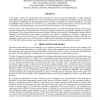Free Online Productivity Tools
i2Speak
i2Symbol
i2OCR
iTex2Img
iWeb2Print
iWeb2Shot
i2Type
iPdf2Split
iPdf2Merge
i2Bopomofo
i2Arabic
i2Style
i2Image
i2PDF
iLatex2Rtf
Sci2ools
MEDIAFORENSICS
2010
2010
Audio annotation watermarking with robustness against DA/AD conversion
In the paper we present a watermarking scheme developed to meet the specific requirements of audio annotation watermarking robust against DA/AD conversion (watermark detection after playback by loudspeaker and recording with a microphone). Additionally the described approach tries to achieve a comparably low detection complexity, so it could be embedded in the near future in low-end devices (e.g. mobile phones or other portable devices). We assume in the field of annotation watermarking that there is no specific motivation for attackers to the developed scheme. The basic idea for the watermark generation and embedding scheme is to combine traditional frequency domain spread spectrum watermarking with psychoacoustic modeling to guarantee transparency and alphabet substitution to improve the robustness. The synchronization and extraction scheme is designed to be much less computational complex than the embedder. The performance of the scheme is evaluated in the aspects of transparency, ...
Forensic Engineering | Low Detection Complexity | MEDIAFORENSICS 2010 | Spread Spectrum Watermarking | Watermark Detection |
| Added | 29 Oct 2010 |
| Updated | 29 Oct 2010 |
| Type | Conference |
| Year | 2010 |
| Where | MEDIAFORENSICS |
| Authors | Kun Qian, Christian Krätzer, Michael Biermann, Jana Dittmann |
Comments (0)

